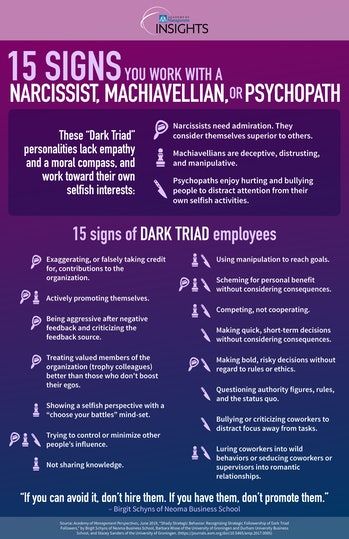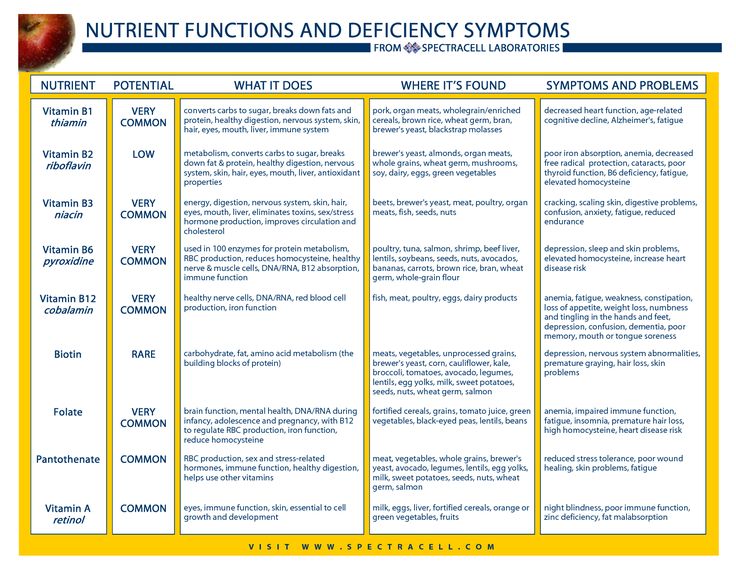Counseling for narcissism
Steps and What to Expect
Narcissistic personality disorder (NPD) is a personality disorder included in the Diagnostic and Statistical Manual of Mental Disorders, Fifth Edition (DSM-5) under the “personality disorders” category.
NPD is characterized by a:
- lack of empathy
- strong need for admiration
- pervasive pattern of grandiosity
We often hear the word “narcissist” used in general conversation. In this context, people are usually referring to one who exhibits some self-centered, vain behavior.
But having the tendency toward narcissistic behaviors doesn’t mean you have NPD. Either way, change is possible.
A 2018 research review showed that true NPD is not common. It requires a diagnosis by a mental health professional, such as a psychiatrist or psychologist.
Treatment for NPD can be challenging. Much depends on the person’s willingness to enter therapy and to stick with it.
There are several forms of therapy that can be used to treat NPD. Let’s take a look at some of them, plus tips on where to find help.
Your mental health provider will begin by assessing your psychological functioning. They’ll also consider differential diagnoses and coexisting conditions before recommending a plan for treatment.
Therapy for NDP will likely involve:
- helping you overcome resistance to therapy
- identifying narcissistic behaviors that are causing problems in your life
- examining past experiences and assumptions that led to narcissistic behaviors
- acknowledging how these behaviors affect others
- replacing grandiose thoughts with more realistic ones
- exploring new patterns of behavior and practicing them
- seeing the benefits of newly learned behaviors
Psychotherapy
Psychoanalysis is a form of talk therapy. Through one-on-one sessions, you’ll explore the reasons behind your feelings and behaviors.
As you begin to understand your past, current emotions and behaviors come into focus. This can help you better manage your thoughts and feelings. Then, you can start changing the way you react to them.
This can help you better manage your thoughts and feelings. Then, you can start changing the way you react to them.
Cognitive behavioral therapy (CBT)
The focus of CBT is to identify unhealthy patterns of thought and behavior and replace them with healthier ones.
You’ll practice new skills with your therapist. You’ll also have homework assignments to put these skills into action between sessions.
There are many CBT techniques, such as:
- journaling
- situation exposure
- cognitive restructuring
- scheduling positive activities
- guided discovery and questioning
Schema therapy
Schema therapy is an integrative approach to therapy. It combines elements of psychotherapy and CBT.
The aim is to help you identify and understand unhelpful patterns and coping mechanisms that formed from early childhood experiences.
Once you uncover these maladaptive schemas, you can learn to modify them. With practice, you’ll find new ways to help meet your emotional needs and change your behavior toward others.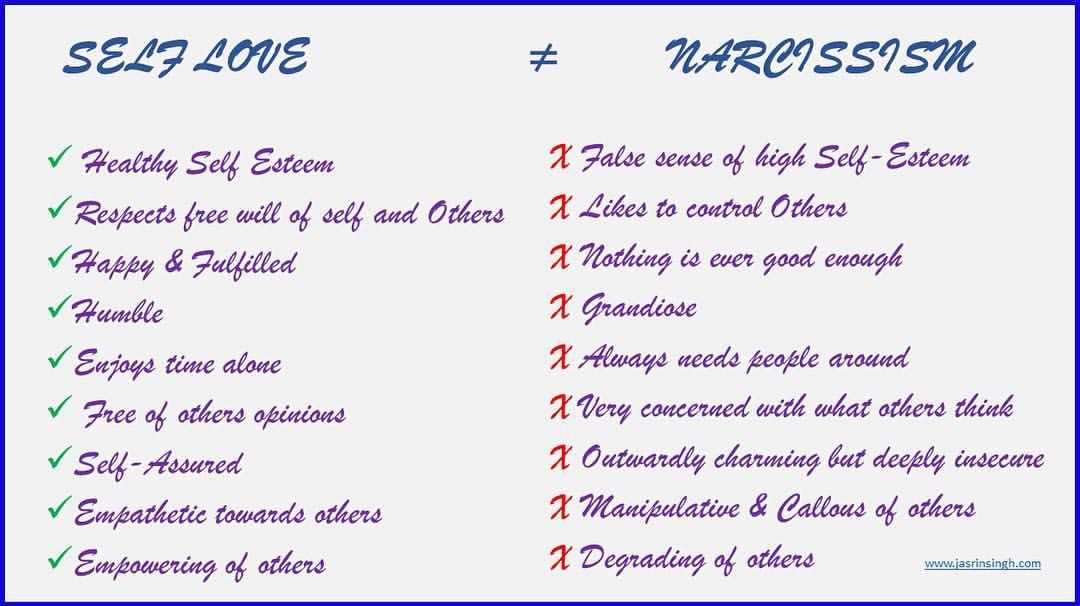
Gestalt therapy
Gestalt therapy is a form of psychotherapy. You’ll focus more on the present than the past or the future. Earlier life experiences are considered in the context of how they affect you today.
You’ll be encouraged to reflect on what’s happening in your life now. You’ll work on improving self-awareness and self-responsibility.
Mentalization-based therapy (MBT)
MBT works on improving your ability to reflect on yourself, as well as the thoughts and emotions of others. Then, you’ll learn to connect emotions to behavior patterns.
You’ll explore the intent behind other people’s behavior and work on thinking things through before reacting.
Transference-focused psychotherapy (TFP)
In TFP, you take your emotions about someone else and direct them toward the therapist. This may make it easier to talk things through. The therapist can help you gain insight into your thoughts and feelings.
Dialectical behavior therapy (DBT)
DBT is a form of CBT with a focus on:
- mindfulness
- emotion regulation
- distress tolerance
- interpersonal effectiveness (relationship skills)
DBT may involve individual and group therapy sessions where you’ll learn and practice new coping strategies.
Metacognitive interpersonal therapy (MIT)
MIT is a step-by-step treatment designed to:
- dismantle narcissistic processes by looking at problems as they pertain to your own life
- recognize maladaptive patterns and interpersonal functioning
- promote change by distancing from old behaviors and building new adaptive patterns
The therapist will also look for barriers to effective therapy and work to help improve them.
Eye movement desensitization and reprocessing (EMDR) therapy
In EMDR therapy, the assumption is that narcissism is based on difficult early life experiences or traumas.
EMDR therapy is a step-by-step process divided into eight distinct phases. As you progress, you’ll be encouraged to address:
- negative memories
- traumatic events
- emotional triggers
As you do, the therapist will direct eye movements to divert your attention. The goal is to lessen the impact of traumatic memories.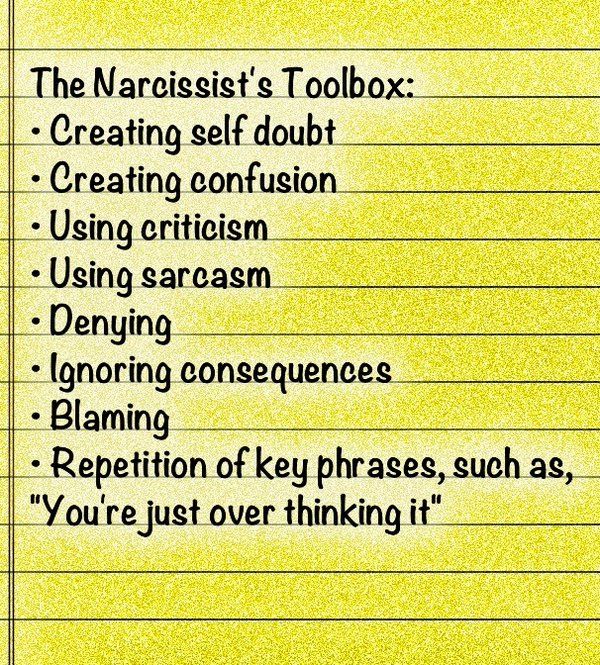
Therapy for NPD is a long process.
You may feel like you’re improving early on, but it’s important not to leave therapy early. It’s likely to take several years — or even longer — to truly make meaningful change.
Other coexisting mental health conditions, such as anxiety, depression, or bipolar disorder should be treated as well.
If you’re concerned that you exhibit narcissistic behaviors, consider contacting a medical or mental health professional for evaluation.
Even if you only have a few tendencies toward narcissistic behavior, therapy can help you look at things differently.
According to a small 2017 review of case studies, people who have NPD experience significant social problems and multiple medical conditions, so it’s worth seeking help.
Also, what appears to be narcissistic behavior could very well be due to another condition. Other causes of similar symptoms include:
- anxiety disorders
- bipolar disorder
- depressive disorders
- other personality disorders
- substance use disorder
NPD doesn’t always present the same way. A broad spectrum may exist that includes covert narcissism and malignant narcissism. A qualified doctor or therapist can help determine the best approach.
A broad spectrum may exist that includes covert narcissism and malignant narcissism. A qualified doctor or therapist can help determine the best approach.
If you’re ready for change, now is the time to take that first step toward improving your life.
You shouldn’t try to diagnose yourself or anyone else with a personality disorder. Symptoms of personality disorders can overlap, and there are often coexisting conditions that play a role.
That’s why it’s best to seek help from a licensed mental health professional. The diagnosis will be made based on the DSM-5.
You can start with your primary care doctor. They can refer you to a qualified psychiatrist or psychologist experienced in the treatment of NPD. You can learn more about finding a provider at these sites:
- Centers for Disease Control and Prevention
- MentalHealth.gov
- National Alliance on Mental Illness
- National Institute of Mental Health
Or, you can search for a care provider using the Healthline Find Care tool.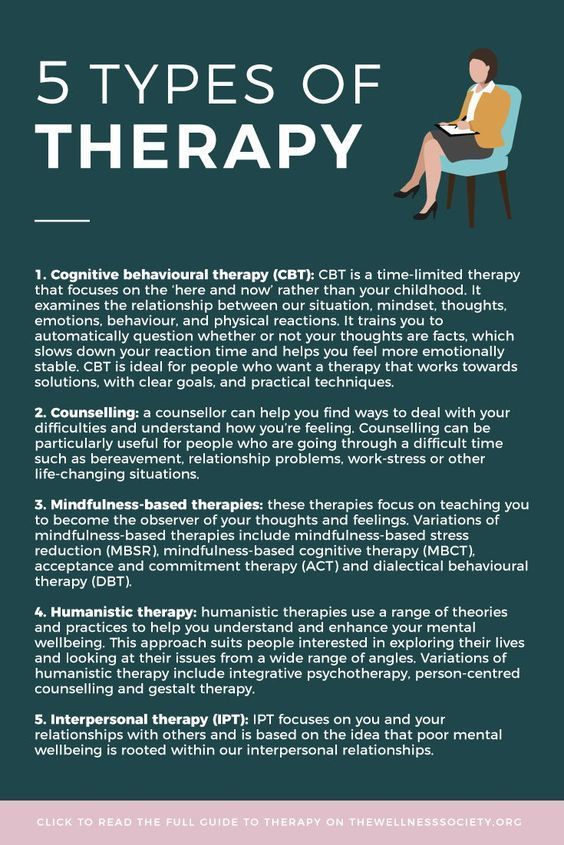
Narcissistic personality disorder is a mental health condition. It’s typified by:
- grandiose ideas
- a lack of empathy
- a deeply rooted need for admiration
Despite frequent use of the word “narcissism” to describe self-centered behaviors, the actual disorder is not common. It takes a mental health professional to make the diagnosis.
Narcissistic behaviors can affect your relationships and your quality of life. But a variety of therapies can help you learn to change these behaviors for the better.
These are usually long-term treatments that depend on a willingness to continue over the long haul.
Steps and What to Expect
Narcissistic personality disorder (NPD) is a personality disorder included in the Diagnostic and Statistical Manual of Mental Disorders, Fifth Edition (DSM-5) under the “personality disorders” category.
NPD is characterized by a:
- lack of empathy
- strong need for admiration
- pervasive pattern of grandiosity
We often hear the word “narcissist” used in general conversation. In this context, people are usually referring to one who exhibits some self-centered, vain behavior.
In this context, people are usually referring to one who exhibits some self-centered, vain behavior.
But having the tendency toward narcissistic behaviors doesn’t mean you have NPD. Either way, change is possible.
A 2018 research review showed that true NPD is not common. It requires a diagnosis by a mental health professional, such as a psychiatrist or psychologist.
Treatment for NPD can be challenging. Much depends on the person’s willingness to enter therapy and to stick with it.
There are several forms of therapy that can be used to treat NPD. Let’s take a look at some of them, plus tips on where to find help.
Your mental health provider will begin by assessing your psychological functioning. They’ll also consider differential diagnoses and coexisting conditions before recommending a plan for treatment.
Therapy for NDP will likely involve:
- helping you overcome resistance to therapy
- identifying narcissistic behaviors that are causing problems in your life
- examining past experiences and assumptions that led to narcissistic behaviors
- acknowledging how these behaviors affect others
- replacing grandiose thoughts with more realistic ones
- exploring new patterns of behavior and practicing them
- seeing the benefits of newly learned behaviors
Psychotherapy
Psychoanalysis is a form of talk therapy. Through one-on-one sessions, you’ll explore the reasons behind your feelings and behaviors.
Through one-on-one sessions, you’ll explore the reasons behind your feelings and behaviors.
As you begin to understand your past, current emotions and behaviors come into focus. This can help you better manage your thoughts and feelings. Then, you can start changing the way you react to them.
Cognitive behavioral therapy (CBT)
The focus of CBT is to identify unhealthy patterns of thought and behavior and replace them with healthier ones.
You’ll practice new skills with your therapist. You’ll also have homework assignments to put these skills into action between sessions.
There are many CBT techniques, such as:
- journaling
- situation exposure
- cognitive restructuring
- scheduling positive activities
- guided discovery and questioning
Schema therapy
Schema therapy is an integrative approach to therapy. It combines elements of psychotherapy and CBT.
The aim is to help you identify and understand unhelpful patterns and coping mechanisms that formed from early childhood experiences.
Once you uncover these maladaptive schemas, you can learn to modify them. With practice, you’ll find new ways to help meet your emotional needs and change your behavior toward others.
Gestalt therapy
Gestalt therapy is a form of psychotherapy. You’ll focus more on the present than the past or the future. Earlier life experiences are considered in the context of how they affect you today.
You’ll be encouraged to reflect on what’s happening in your life now. You’ll work on improving self-awareness and self-responsibility.
Mentalization-based therapy (MBT)
MBT works on improving your ability to reflect on yourself, as well as the thoughts and emotions of others. Then, you’ll learn to connect emotions to behavior patterns.
You’ll explore the intent behind other people’s behavior and work on thinking things through before reacting.
Transference-focused psychotherapy (TFP)
In TFP, you take your emotions about someone else and direct them toward the therapist. This may make it easier to talk things through. The therapist can help you gain insight into your thoughts and feelings.
This may make it easier to talk things through. The therapist can help you gain insight into your thoughts and feelings.
Dialectical behavior therapy (DBT)
DBT is a form of CBT with a focus on:
- mindfulness
- emotion regulation
- distress tolerance
- interpersonal effectiveness (relationship skills)
DBT may involve individual and group therapy sessions where you’ll learn and practice new coping strategies.
Metacognitive interpersonal therapy (MIT)
MIT is a step-by-step treatment designed to:
- dismantle narcissistic processes by looking at problems as they pertain to your own life
- recognize maladaptive patterns and interpersonal functioning
- promote change by distancing from old behaviors and building new adaptive patterns
The therapist will also look for barriers to effective therapy and work to help improve them.
Eye movement desensitization and reprocessing (EMDR) therapy
In EMDR therapy, the assumption is that narcissism is based on difficult early life experiences or traumas.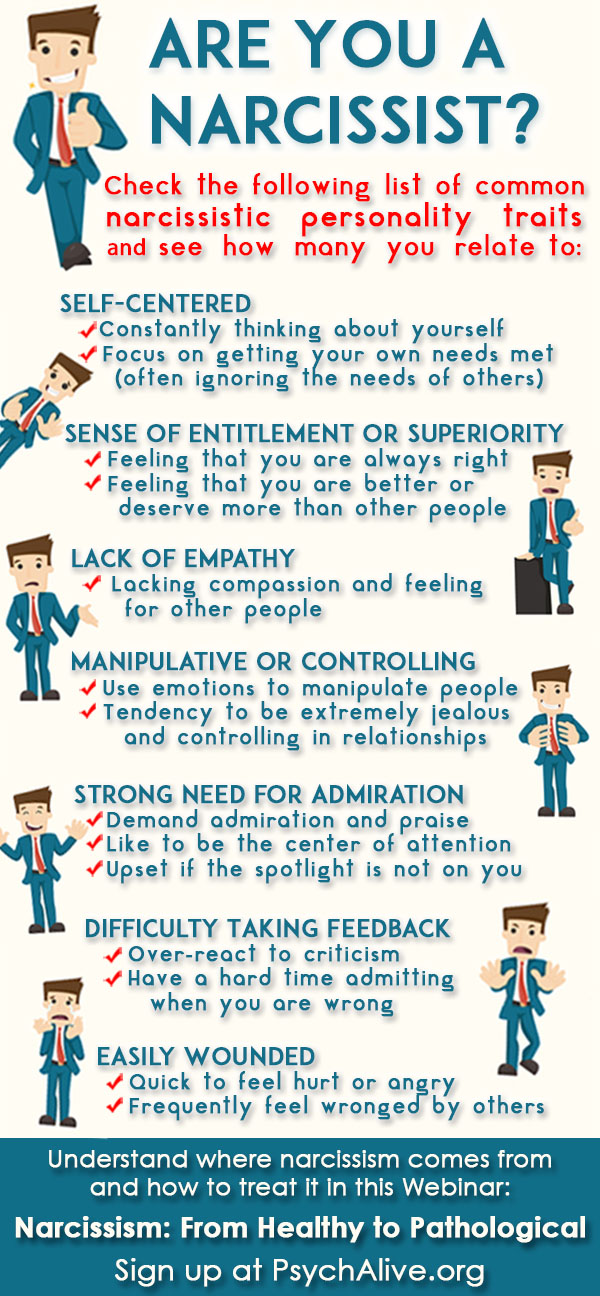
EMDR therapy is a step-by-step process divided into eight distinct phases. As you progress, you’ll be encouraged to address:
- negative memories
- traumatic events
- emotional triggers
As you do, the therapist will direct eye movements to divert your attention. The goal is to lessen the impact of traumatic memories.
Therapy for NPD is a long process.
You may feel like you’re improving early on, but it’s important not to leave therapy early. It’s likely to take several years — or even longer — to truly make meaningful change.
Other coexisting mental health conditions, such as anxiety, depression, or bipolar disorder should be treated as well.
If you’re concerned that you exhibit narcissistic behaviors, consider contacting a medical or mental health professional for evaluation.
Even if you only have a few tendencies toward narcissistic behavior, therapy can help you look at things differently.
According to a small 2017 review of case studies, people who have NPD experience significant social problems and multiple medical conditions, so it’s worth seeking help.
Also, what appears to be narcissistic behavior could very well be due to another condition. Other causes of similar symptoms include:
- anxiety disorders
- bipolar disorder
- depressive disorders
- other personality disorders
- substance use disorder
NPD doesn’t always present the same way. A broad spectrum may exist that includes covert narcissism and malignant narcissism. A qualified doctor or therapist can help determine the best approach.
If you’re ready for change, now is the time to take that first step toward improving your life.
You shouldn’t try to diagnose yourself or anyone else with a personality disorder. Symptoms of personality disorders can overlap, and there are often coexisting conditions that play a role.
That’s why it’s best to seek help from a licensed mental health professional. The diagnosis will be made based on the DSM-5.
You can start with your primary care doctor. They can refer you to a qualified psychiatrist or psychologist experienced in the treatment of NPD.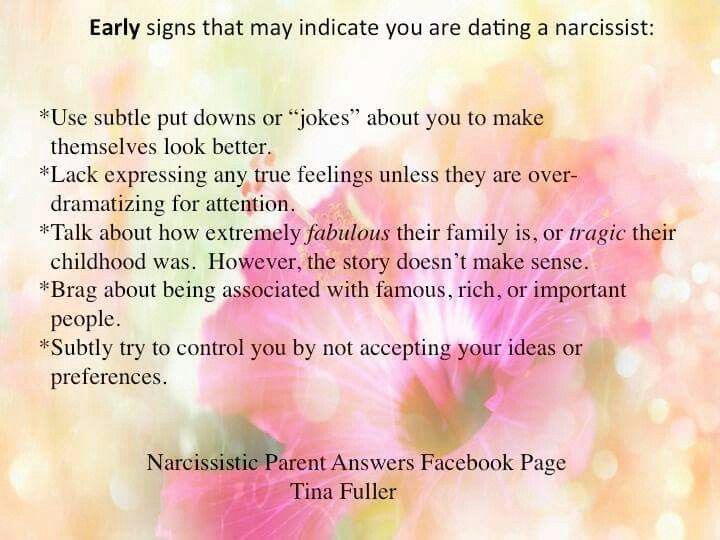 You can learn more about finding a provider at these sites:
You can learn more about finding a provider at these sites:
- Centers for Disease Control and Prevention
- MentalHealth.gov
- National Alliance on Mental Illness
- National Institute of Mental Health
Or, you can search for a care provider using the Healthline Find Care tool.
Narcissistic personality disorder is a mental health condition. It’s typified by:
- grandiose ideas
- a lack of empathy
- a deeply rooted need for admiration
Despite frequent use of the word “narcissism” to describe self-centered behaviors, the actual disorder is not common. It takes a mental health professional to make the diagnosis.
Narcissistic behaviors can affect your relationships and your quality of life. But a variety of therapies can help you learn to change these behaviors for the better.
These are usually long-term treatments that depend on a willingness to continue over the long haul.
How to cure narcissism.
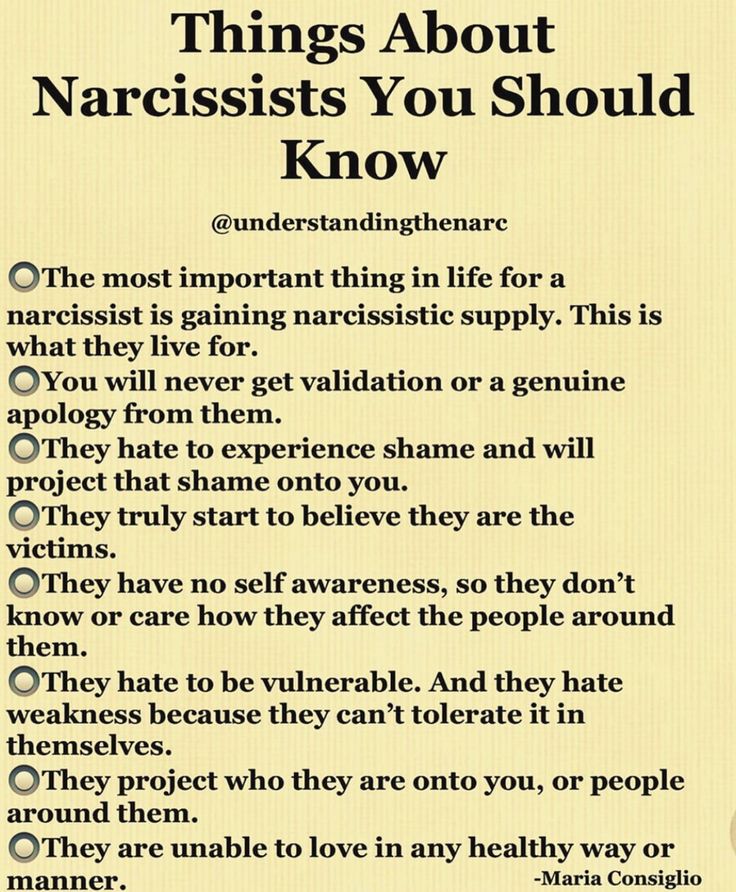 Stages of psychotherapy with examples
Stages of psychotherapy with examples We analyze the strategy of working with a narcissistic character - how psychotherapy helps narcissists and what a narcissist can do for himself.
In a previous article, I talked about the formation of narcissism and about the characteristics of the suffering that is characteristic of narcissists. I recommend reading it to understand the basic terms. In this article, we will deal with strategies for helping and self-help.
The first and most important thing I want to say. Dealing with narcissism is not easy. It is painful and difficult. Sometimes it seems like you are standing still. But narcissists, like no one else, are helped along this path by intelligence and diligence. Therefore, I recommend that anyone who suspects narcissistic traits in themselves carefully study the professional literature. This will be of great help - tested on people. nine0003
Now let's look at a strategy for dealing with the narcissistic character.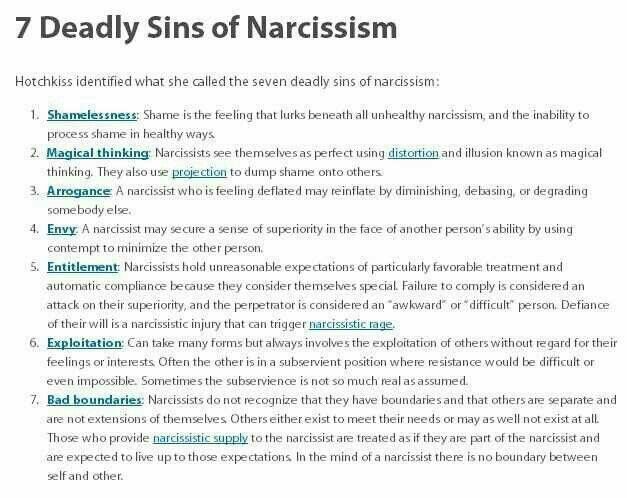 I do not pretend to be complete - this is simply impossible to do within the framework of a short article. Rather, my goal is to briefly outline the main areas of work and give a general idea of \u200b\u200bthem. I hope this will be of help to you both in personal therapy and in independent work.
I do not pretend to be complete - this is simply impossible to do within the framework of a short article. Rather, my goal is to briefly outline the main areas of work and give a general idea of \u200b\u200bthem. I hope this will be of help to you both in personal therapy and in independent work.
What Makes Therapy of Narcissism Difficult
As I have already written, usually the narcissist becomes anxious when the symptomatic self is actively manifesting itself - it can be anxiety, depression, just low mood, any physical symptoms. nine0003
You already know that the symptomatic self is the bridge to the true self. That is, in fact, through the symptom, a deep feeling of discomfort appeals to you, the shirt is not on the shoulder, the compulsion to live not your own life, but someone else's. The one that your parents once imposed on you.
It is logical that exacerbations often occur against the background of crises: dismissal, relocation, marriage, divorce, etc.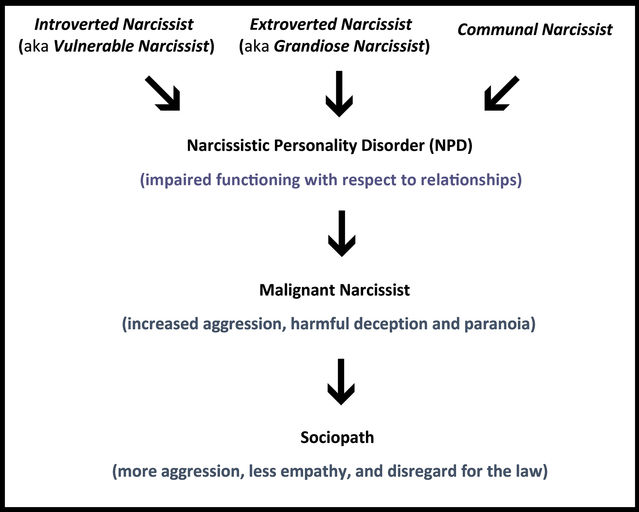 The defense of the fake self is weakening a bit, and the authentic self is getting a chance.
The defense of the fake self is weakening a bit, and the authentic self is getting a chance.
And everything would be great: the crisis would open the way to the real self, to one's own destiny, as is often the case in books and films. But the problem is that the true self of the narcissist is stuck at the level of two or three years. It is very different from the brilliant picture that we have become accustomed to over the years of success. And so when you first look your true self in the eye, it's hard to feel anything other than disgust. It's not me, I'm not like that at all, put it away. nine0003
For the narcissist, realizing who you really are is essentially a retraumatization. After all, narcissistic trauma occurs when parents reject a child, do not want to see him as he is. And this is the usual view of the narcissistic personality on himself: everything weak is cut off, everything strong is nurtured.
It is not surprising that usually a narcissist who has fallen into a crisis state wants only one thing: to return everything back, to feel as grandiose again as before the crisis. nine0003
nine0003
And this is a big trap. Returning to a former life is like redecorating a house that is falling apart. Might be a good temporary measure. But at one point, the walls will crack again, and these cracks will be even deeper.
It is important to realize that in the pursuit of success you lose your real, real life, in which you can be truly happy. Which you were actually born for and which suits you much better than what is now.
Stages of psychotherapy of a narcissistic character
If we formulate the main, fundamental goal of working on oneself for a narcissistic personality, then this will be the discovery and strengthening of an authentic self and natural self-expression. You need to complete the work of the psyche that was impossible in your childhood - to relive the period in which infant grandiosity collides with reality.
For convenience, I have divided the therapeutic process into four stages.
Step 1: Decipher the symptoms
The first stage of work is to learn to see how the symptomatic self manifests itself in your life.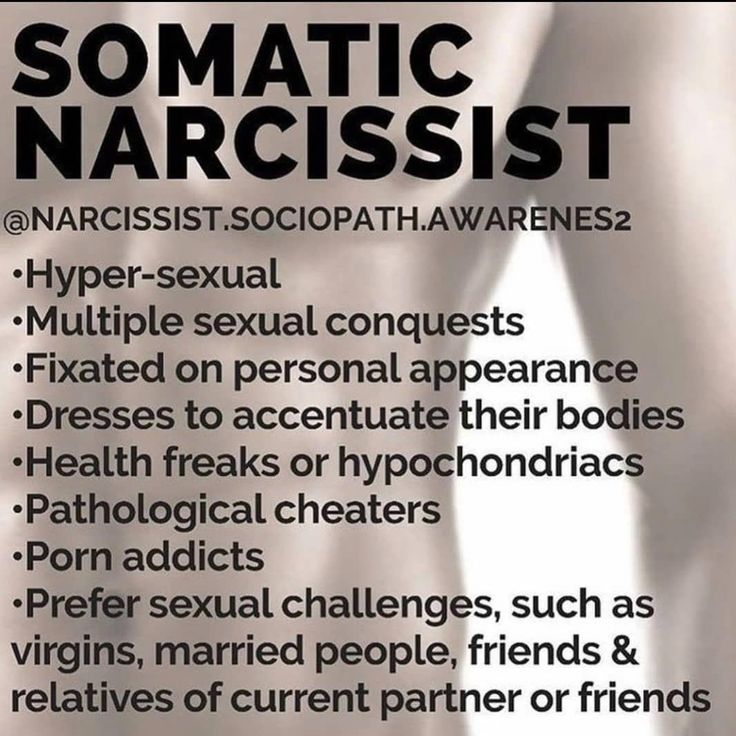 Learn to interpret his signals as the voice of the true self.
Learn to interpret his signals as the voice of the true self.
Pain is chronic inhibition of impulses. You can work with the boss you hate for many years, and it would seem that you get used to it for a long time. And blame the headache on an uncomfortable posture at the desk. And you will be partly right: a symptom always strikes at a weak spot. And it is quite possible to drown out this pain with NSAIDs. But in fact, the suppressed pain from the behavior of the boss does not go anywhere. Headache will be replaced by back pain, back pain will be replaced by chronic fatigue. Symptoms will roam around the body haphazardly until they put you in the hospital for a month or two. nine0003
The task of the first stage of work is to see and recognize how much you sacrifice yourself for the sake of other people's goals and desires. Stop running away from unpleasant emotions and states, allow yourself to feel them. Admit that you are hurt by harsh comments from your boss and wife/husband. That you can come to your senses for a long time after these comments, hang in self-accusations, feel nausea and hatred for yourself, for them, for the whole world.
That you can come to your senses for a long time after these comments, hang in self-accusations, feel nausea and hatred for yourself, for them, for the whole world.
At this stage, at first there is a lot of denial, then a lot of shame. Pain is embarrassing. The inability to get together and do it is shameful. nine0003
It helps to realize that pain is really just a signal. It shows where you need to pay attention, what you need to devote time to. It hurts you, not because you are a weak and weak-willed person. These are the echoes of trauma. You can and should work with them.
Stage 2. Study compensatory mechanisms
This stage is also unpleasant and painful. But it is a bit more portable than the previous one, because at this stage there is already a small result and therefore hope. nine0003
Very simply explained, at this stage we begin to analyze how our mental pain arises, what causes it, and how our false self works. to protect us from this pain.
F. Summers writes about the five main compensatory mechanisms of the narcissistic defect. I'll talk about them briefly so you can get a general idea of what it might be like. But remember that the history of each injury is individual and has its own characteristics.
Summers writes about the five main compensatory mechanisms of the narcissistic defect. I'll talk about them briefly so you can get a general idea of what it might be like. But remember that the history of each injury is individual and has its own characteristics.
Submission is the desire to satisfy someone else's ambitions. This strategy is adopted by children who are accustomed to living in accordance with the goals of their parents. In this case, the achieved goal does not bring us satisfaction, but rather brings relief: cheers, the parents (or the boss) will be satisfied, they will leave me behind for a while.
The strategy is so consolidated that we don't even notice how fervently we cling to the tasks assigned to us, and we realize that we swallowed too much a piece, already when we agreed to a new project and did half. nine0003
Submission helps to maintain close relationships with significant people - unfortunately, at the expense of its own authenticity.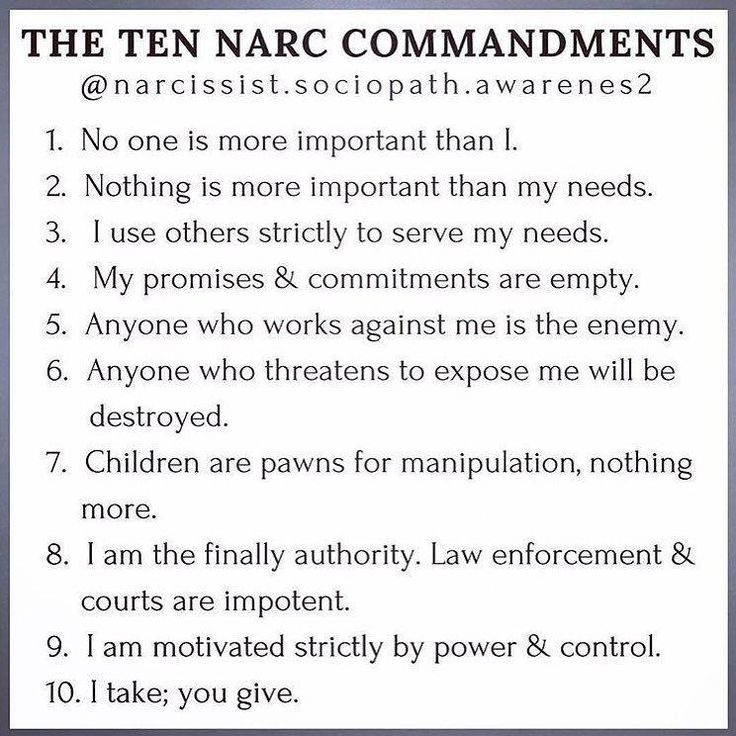
Grandiosity is the creation of an exaggeratedly successful image of oneself and the desire to maintain it with the help of confirmation from others, the constant search for approval. So, we can ignore any claims of superiors against us, saying that we are indispensable at work and we are unfairly evaluated. By convincing others of our success, we are convinced of this ourselves. nine0003
Probably the most striking example of the compensatory mechanism of grandiosity is an exaggeratedly beautiful profile in social networks, from which it all the time sounds false.
Depreciation is an overestimation of one's own value compared to others. When using this mechanism, it seems to us that everyone around us is doing wrong, does not have a single dignity, and only brings harm. "I had three husbands - and all, as if by selection, the same bastards." “Wherever I go to work, there are some exceptionally stupid people around.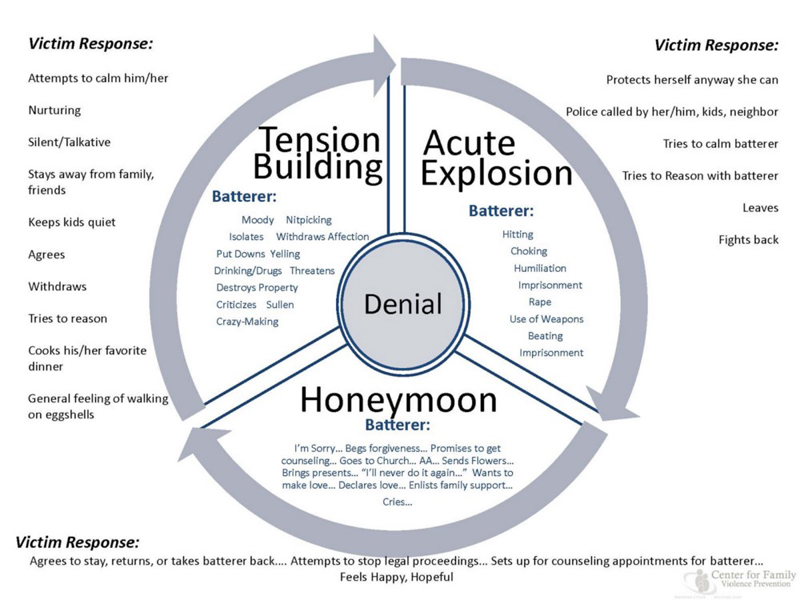 ” Only when you look from the outside, you can notice an exaggeration in this - from the inside, such a picture seems to be a reality. nine0003
” Only when you look from the outside, you can notice an exaggeration in this - from the inside, such a picture seems to be a reality. nine0003
Idealization - attributing exaggerated virtues to another person and identifying with this person. It's sort of the opposite of depreciation. In this case, on the contrary, someone is put on a pedestal, almost deified, and relations with him help us to become involved in this splendor too. As long as we are in relationship with the ideal object, we also become ideal.
Most likely, this mechanism is familiar to you from popular articles. They usually write about narcissists that they first idealize a partner, and then devalue them. But they don’t write how painful it is to live if you yourself are a narcissist. And what wild pain is behind the desire to find the ideal. nine0003
Compulsive attachment - strong attachment to a reliable partner who is able to admire us and who, as we think, will never leave us. In this case, the partner plays the role of a transitional object - it seems that if we are surrounded by admiration, all our wounds will heal and we will no longer feel defective. That is, in this case, our partner is perceived by us not as an individual, but simply as a good mirror.
In this case, the partner plays the role of a transitional object - it seems that if we are surrounded by admiration, all our wounds will heal and we will no longer feel defective. That is, in this case, our partner is perceived by us not as an individual, but simply as a good mirror.
Being aware of each of these compensatory mechanisms raises a logical question: what do I need them for? What am I really protecting myself from? And this is the beginning of the next stage of work. nine0003
Stage 3. Get in touch with the true self and relive the trauma
At this stage, we have a long way to go deep into our narcissistic trauma.
In fact, we come to the deconstruction of the processes on which our development was once interrupted. We return to that moment in our history when mom or dad tells us for the first time: “Stop singing, you are very out of tune!”, “Stop dancing! Where did you get such vulgarity! You are still small, but you are behaving like a depraved woman!” - or, on the contrary: “You are so talented, you have a real gift! Come on, you will study English 4 times a week! Let's skip the pool. I understand that you like it there, but then you will thank me.” nine0003
I understand that you like it there, but then you will thank me.” nine0003
And as we begin this deconstruction, feelings that have been blocked rise to the surface. The pain that they do not like me for who I am. Resentment that mom is always more interested in her fantasy, and not the real me. Furious that in order to be loved, I have to sit and study English, which is boring to me, and not play football with the boys on the street.
And then we can go even deeper and find behind the pain, resentment and rage a huge unmet need for love, closeness, acceptance, reflection of us as we are. nine0003
Usually the scale of this need, which for many years remained buried under a false self. grandiose. This is the very infantile need for a good mother, who can lovingly relate to my attempts to master the new world, admire me and carefully handle my fragility.
Understanding that this need is there, that it is not going anywhere, and that the best thing you can do for yourself - to slowly look for ways to satisfy it - will greatly advance you. And, at least, it will inspire you to treat yourself more carefully than before. nine0003
And, at least, it will inspire you to treat yourself more carefully than before. nine0003
Stage 4. Develop the true self
The last stage is to relive the phase of development where you stopped due to trauma.
As we have already discussed, in the phase of new rapprochement, the child manifests natural auto-expression - he begins to listen to the movements of his soul, try different new activities, find out what he likes and what he does not like. He is still very vulnerable. He is easily embarrassed. Supporting the process of self-expression is quite a piece of jewellery, in which you need to both support and help match desires with reality. nine0003
Since adult narcissistic clients come to a psychologist, they usually already know how to live well in the adult world and realistically assess their possibilities. Usually it is enough just to change the vector a little - to learn to focus primarily on yourself, and not on others, as happened when the client was owned by compensatory mechanisms like submission.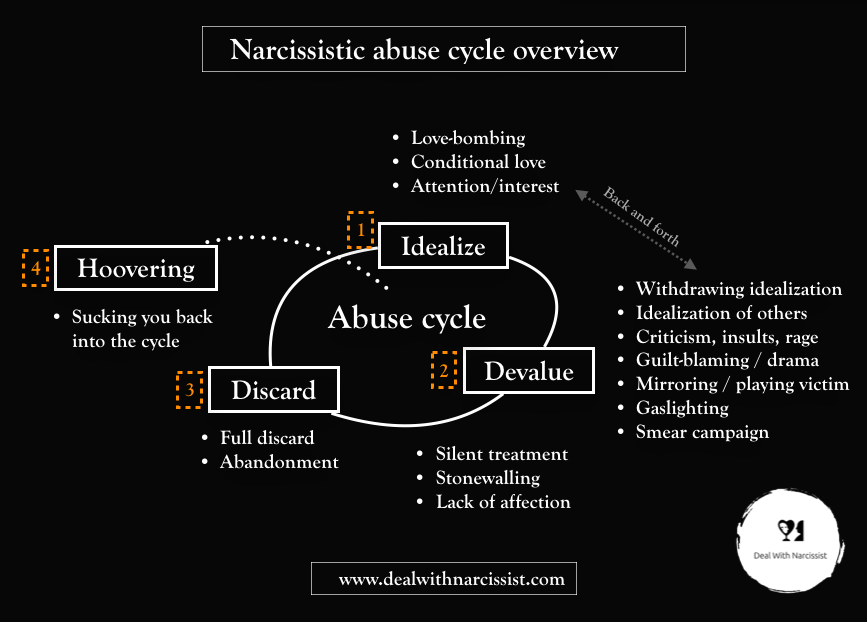
At this stage, the social environment plays an important role. It is very important to find an adequate social system that can support your auto-expression. It could be a university, a job, a hobby, a psychology group, or a training program. A space where you can try new things and be accepted and supported in this. nine0003
A couple of important notes for those who survived =)
The strategy I have described is several years of work under the strict guidance of a psychologist. A good psychologist usually knows what he is doing and has successfully walked this path himself in the past. So if you are suddenly upset that you can’t repeat it all yourself, don’t be upset. This is basically not realistic.
I wrote this article so that you can use it as a map in your work with a psychologist - see where you are now. It is possible to discuss with a psychologist what is preventing you from going further. I think this orientation is very important. nine0003
If you haven't started working with a psychologist yet, then I hope you've become a little clearer about the specifics of a narcissistic character, where to start on the path to recovery, and what traps you may encounter on it.
I work with narcissistic clients in Moscow and via Skype - if you need help, write. Details on the registration page.
I can offer colleagues the format of case supervision or therapeutic supervision (exploring your countertransference in relation to the client's story and your personal story). nine0129
If you have any questions, ask in the comments, I will definitely answer.
What to read
S. Johnson, Character Therapy
F. Summers, Beyond the Self.
O. Kernberg, Severe Personality Disorders.
H. Kohut, Analysis of the Self.
I. Mlodik, "While you were trying to become God."
Helpful? Join my VKontakte group:
You can also find me on FB, LiveJournal and Telegram:
Narcissism in simple words - Psychotherapist's consultations
Narcissism in simple words - a flower called Narcissus is known. When it grows near water bodies, its inflorescence, tilted to one side, is like admiring its reflection in the water.
When it grows near water bodies, its inflorescence, tilted to one side, is like admiring its reflection in the water.
Narcissism is a disease of modern society. This ailment has been known since antiquity, but now it is especially popular. In the era of the Internet and social networks, people have developed the habit of posting edited content about themselves and collecting likes and comments. A person thereby brings up in himself dependence on someone else's approval. The narcissist is a narcissist who needs constant confirmation of his uniqueness. nine0129 The founder of psychoanalysis, Sigmund Freud, gave this name to the type of people who are absorbed in themselves, borrowing the name from the myth of Narcissus.
Narcissism in simple words:
According to one of the legends, he was the son of the ancient Greek god of the rivers Kefiss and the nymph Liriope. He was very handsome and admired himself, not paying attention to anyone around him. The nymph Echo, seeing a beautiful young man, fell in love with him, but he could not reciprocate her, because he paid all his attention only to himself. This caused the wrath of the goddess of justice Nemesis, and she cast a curse. Narcissus was forever deprived of the opportunity to experience mutual love. The feelings of the nymph Echo remained unanswered. She began to wither from grief. All that was left of her was her voice. And Narcissus, in love with himself, could not take his eyes off the reflection of his face in the river until his death. nine0003
This caused the wrath of the goddess of justice Nemesis, and she cast a curse. Narcissus was forever deprived of the opportunity to experience mutual love. The feelings of the nymph Echo remained unanswered. She began to wither from grief. All that was left of her was her voice. And Narcissus, in love with himself, could not take his eyes off the reflection of his face in the river until his death. nine0003
Narcissistic personality disorder is characterized by pride, selfishness, belief in one's own superiority, conceit, expectation of admiration, and dependency on approval from others.
The life of such people consists of creating around them an atmosphere of respect, satisfaction from themselves, and a desire to control approval from outside. Such people deep down feel unloved. Overconcern with its significance in society indicates a lack of attention to internal processes. The narcissist looks for a reflection of his own perfection in other people, and cannot find in himself a sense of self-satisfaction.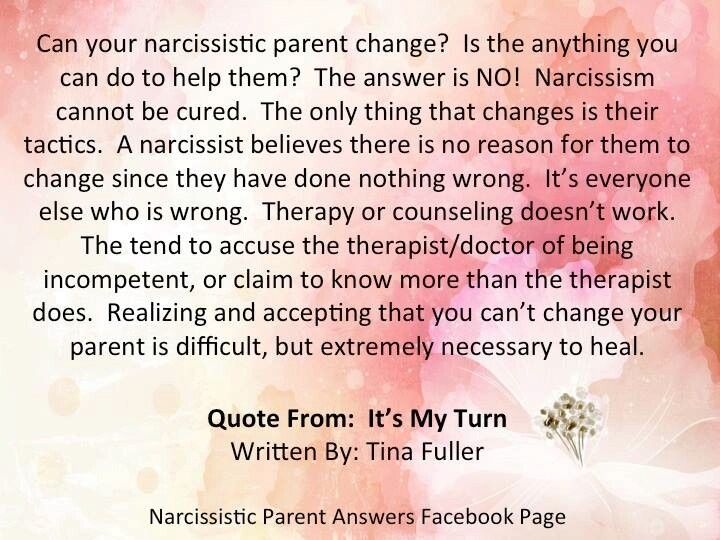 nine0003
nine0003
Such people tend to talk about external things - beauty, wealth and fame. Caring about the image comes to the fore and turns a person away from the true self. Narcissists tend to choose the best: the best education, the best doctors, the best car, the best restaurant seat, and so on. They set high standards and unrealistic expectations for themselves. Perfection, brought to fanaticism. Either they praise themselves for achievements, or they strongly criticize for shortcomings and failures, thereby falling into depression. nine0003
Such people are able to take leading roles and lead people, subordinating them to their whim. In society, the narcissist carries himself haughtily and self-confidently - a preoccupied, selfish child, inside of whom fear at the thought that he is not suitable.
Aggression, shame, envy and fear accumulate inside. The shame of being seen as wrong, inadequate, helpless. Jealousy arises for those who look content and have qualities that a person with a narcissistic disorder lacks, and a desire to destroy what the other has.